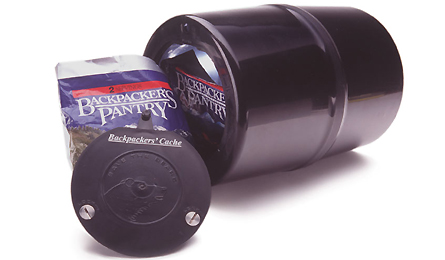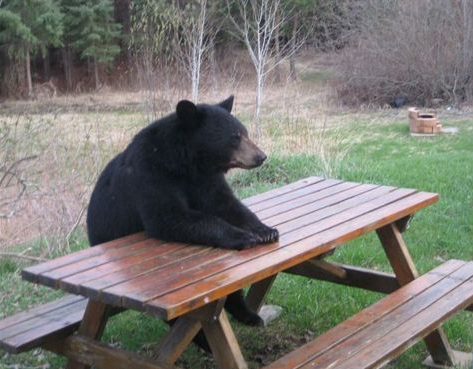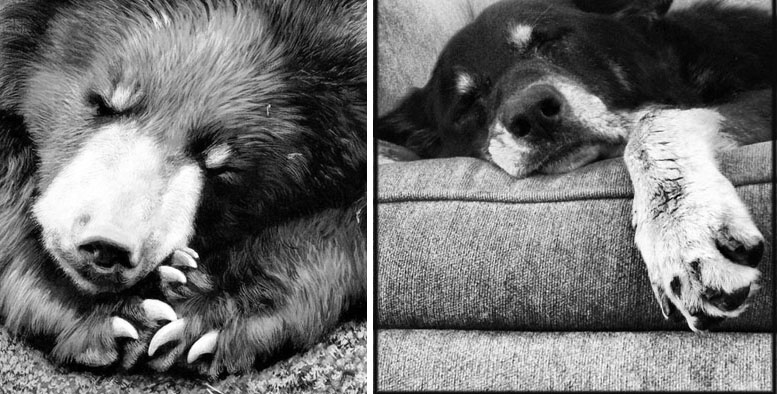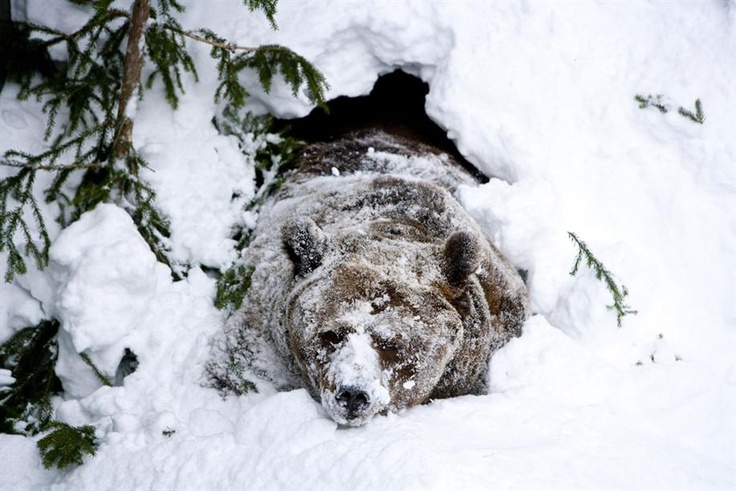Have an ice cold bear: Can you safely camp without a bear canister in winter in Harriman State Park? (also: I know this is actually a grizzly :0)
Can you confidently hole up in a lean-to, knowing the black bear is snugged away, sleeping like a big fuzzy baby until he wakes in spring, refreshed and ready to kill?
Back from a long visit with family in Australia, I found a nice email in my inbox (thanks, Justin!). The topic was black bears, and whether you need a bear canister for your food in the winter, if you’re staying in one of Harriman State Park’s lean-tos.

A typical, commercially-made bear-resistent canister. The New York DEC requires their use between April 1 and November 30.
And the question is: do you need a bear canister in the winter months, when black bears are dormant? Or can you confidently hole up in a lean-to, knowing the black bear is snugged away, sleeping like a big fuzzy baby until he wakes in spring, refreshed and ready to kill?
This topic had come up in conversation just a couple days earlier, and at the time we’d called New York State’s DEC.
They told us that a bear canister — a specially-made container that’s strong enough to withstand the terrible claws of a hungry black bear — is REQUIRED in the Adirondack High Peaks area to thwart bear-to-human encounters (and you’ll suffer a fine if you don’t use one). But the DEC only requires them to be used between April 1 and November 30, after which a time when they consider the black bear to be dormant and a-snooze in his den sets in.

Bear-to-human interactions have been more common in Harriman in recent years, especially near the shelters.
Outside the Adirondacks, they recommend using a canister in the Catskills as well. To that, I think it’s safe to add Harriman State Park, as several bear sightings have been reported near the lean-tos in the park. And you don’t have to hike that far into the “Many Swamp” area of east Harriman, in the vicinity of the Ramapo Equestrian Center, along old disused trails and woods roads that should be named Black Bear Dung Trail, to feel a like an ANB (Aggressive Nuisance Bear) is following you.
But in winter, you can safely leave the canisters at home. A black bear will rise occasionally to scratch himself, turn around, and settle back in until early March. Their metabolism slows to the point where they neither need to eat or go potty. At least, that’s what the DEC says.

Sleeping black bear (left) and sleeping Wolf, my elderly shepherd and former almost-lifelong-shelter dog.
By the way, the DEC’s page on black bears and canisters is a good read (“Some campers even report that the canisters provide an impromptu seat.”)
You can also read the New York Times’ account of “an extremely shy, middle aged black bear named Yellow-Yellow” who was adept at defeating the BearVault 500 bear canister in the Adirondacks.
If you’ve had a black bear encounter in winter (or any other time of year in Harriman), leave a comment!




Went hiking on 11/23 near Claudius Smith Den. I didn’t see any bears. But i crossed paths with two guys who said they saw a cub down the way.
Wow — I wonder if that’s late for hibernation around Harriman. Maybe bring a bear canister. :0)
Comments below were made by Cynthia Tollo, the Harriman Bear Lady:
refreshed and ready to kill
ANB (Aggressive Nuisance Bear) is following you.
Bears really are not killers of anything other than insects and trees. They eat carrion.
If ANB is such a nuisance I don’t know why I can’t see him. I have been in that neighborhood many times this year. We know the bear(s) there but have not seen one in Ladentown since two years ago. At one point, there were four bears at the Mt. Ivy Diner. That was also a couple of years ago. All the skat in the area has had natural foods in it.
Pregnant female bears will be having their cubs any day now. Most people think bears are sleeping right through labor and delivery. Bear goes through many of the same things people do, they prepare the nursery, go through labor pains, have the cubs, nurse them. Bear cubs cry like human babies. Mama is awake everyday nursing them. Gets in a nap when the babies are asleep. Newborns do not hibernate. Last new moon this week called a Bear Moon by native americans.
Thanks for that, Bob (and Cynthia). I love that Harriman has a Bear Lady!
I hope the bears at the Mt. Ivy Diner moved deep into the woods — that’s a busy road. This fall there was a pair of black bears hanging around Big Hill shelter, and some hikers left notes in the lean-to about them.
“Refreshed and ready to kill” was just a little joke, but “Aggressive Nuisance Bear” is an expression I see sometimes used to describe bears that come too close to suburban habitats. I wouldn’t ever consider a wild bear a nuisance, no matter how close he came to my house. I’m sure I’ve gotten closer to his house than he has to mine, and more than once.
A recent story about a group of bears in residential Alaska used the term “aggressive nuisance bears”. The bears were tranquilized, transported to man-made dens and studied as they hibernated and then, when the study was complete, they were “euthanized”, a term used perversely to describe the killing of perfectly healthy bears.
Good info in your comment — thank you so much, and I hope some day to run into the Bear Lady. :0)
I live right by the long path that goes through Harriman. 2 Winters ago you can see this photo what the police estimate was a 300 pound bear. So much for them hibernating all the time (you can the snow)
https://www.facebook.com/photo.php?fbid=3631970511078&set=pb.1028591121.-2207520000.1389927007.&type=3&theater
Better photo taken Nov 1 https://www.facebook.com/photo.php?fbid=2344644688737&set=pb.1028591121.-2207520000.1389927421.&type=3&theater
Gary, as much as I like that picture, if you’d just been a little more patient I’m sure you would have gotten the shot of him climbing into the Cozy Coop and driving around in cute little circles, doing doughnuts on your lawn.
Now, to be fair to the bear (and this typist), the DEC enforces the bear canister regulation up UNTIL November 30, which technically gives your bear thirty days to get in the hole and stay there. So maybe he’s just fattening up for the winter in your November 1 picture…
Thanks Suzy
I’ll be sure to use a Be a Canister if I camp out. Out neighbor’s should have secured their garbage a bit more 🙂
https://www.facebook.com/photo.php?fbid=2344644688737&set=pb.1028591121.-2207520000.1389927421.&type=3&theater
Get this: Bears in the northeast really do not hibernate since at times it is too warm. They do more like you and me when we wake up at night. They just simply turn over and wait for the “dawn” to come.
My friend and I will be doing a 3 day backpack in Harriman next weekend and we will be bringing a canister. I have seen bear tracks in the park during the winter, though it was about 10 years ago. But, from a little bit of research, it seems as though the population has grown since then. Also, the park is not as clean as it once was and that creates more food opportunities for bear.
Robert, How was your weekend in Harriman? Any bear sightings? I was looking for a good not too aggressive overnight. Would you have any suggestions? Planning to snowshoe where needed. Thinking a good 6-8hr day hike and maybe a 3-4hr loop or return to the parking lot. Thanks in advance.
Today I saw my first black bear on the trail in Harriman! It was a large adult slowly walking across the Blue Disc, halfway between Elbow Brush and Claudius Smith. My first instinct was to quickly retreat but my friend, who grew up in the woods of NH, said we should wait quietly since he didn’t see us, then go on our way. Fun day in the drizzly woods 🙂
That’s great, Lyn! That’s an experience I’d like to have this year. I was reading an old nature guide to Harriman from the ’30s and it listed all the mammals in the park, and the black bear wasn’t mentioned. But they seem to be on the rise these days. Well-spotted. :0)
I am planning a late august trip to camp out at Bald Rocks shelter and maybe near island pond with my pre-teen kids. I am planning a Friday and Saturday night, so will need some food. I grew up hiking and camping in Harriman, with reckless abandon in terms of wild life (nothing bad, just did no prep for seeing anything other than the occasional raccoon). More recently, I have seen one black bear in Harriman (Seven Hills heading towards Pine Meadow), but I am wondering how real the threat of seeing a bear is. Naturally with children I am a little more concerned. Thanks for your opinion.
Spotted two bear cubs on the blue trail near the lake sebago boat launch on September 13, 2016.
Saw quite a large black bear today (July 8, 2018) by the Beaver Dam up behind Lake Skannatati. We came upon him while he was pushing down a large bush. Gave us a good fright. He was reasonably placid and did not make any menacing moves towards us.
I met two black bears about 200 lbs each on the way to the Fingerboard shelter, Ramapo – Dunderberg trail, 7/14/18. There were other hikers but bears showed no intention of moving away. I was able to take 20 minute long video and edited to 5 minutes and posted it to YouTube.
Please check it:
https://youtu.be/kDfSbGeiK3o
Solo stealth camping Sept 2018. Bear slapped the ground while I was in a tent at Lilly Pond. Sounded like two baseball mitts slapping the ground. Felt the earth shake though my sleeping pad.
Saw a bear at the beginning or end, depending on your direction, of the Ramapo – Dunderberg trail on 10/15/20. S/he was laying out sunning in the glorious weather. I was just about to leave the park when I saw it. I ended up turning around and bushwacked to the Kakait Trail out of the park. I’ve been so anxious about seeing a bear every time I go camping and hiking (typically solo) that when it actually did occur, I recognized my anxiety was pretty spot on. The unnerving feeling is not something I’m good at handling so I might have to pass on Harriman State Park excursions in the future. Yes, I have bear spray and have practiced using it but it’s still a rattling experience.